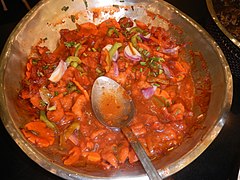
Bistek, also known as bistek tagalog or karne frita, is a Filipino dish consisting of thinly-sliced beefsteak braised in soy sauce, calamansi juice, garlic, ground black pepper, and onions cut into rings. It is a common staple in the Tagalog and Western Visayan regions of the Philippines. It is eaten over white rice.

Tinola is a Filipino soup usually served as a main course with white rice. Traditionally, this dish is cooked with chicken or fish, wedges of papaya and/or chayote, and leaves of the siling labuyo chili pepper in broth flavored with ginger, onions and fish sauce.

Picadillo is a traditional dish in many Latin American countries including Mexico and Cuba, as well as the Philippines. It is made with ground meat, tomatoes, and also raisins, olives, and other ingredients that vary by region. The name comes from the Spanish word picar, meaning "to mince".

Kaldereta or caldereta is a goat meat stew from the Philippines. Variations of the dish use beef, chicken, or pork.

Inihaw, also known as sinugba or inasal, are various types of grilled or spit-roasted barbecue dishes from the Philippines. They are usually made from pork or chicken and are served on bamboo skewers or in small cubes with a soy sauce and vinegar-based dip. The term can also refer to any meat or seafood dish cooked and served in a similar way. Inihaw are commonly sold as street food and are eaten with white rice or rice cooked in coconut leaves (pusô). Inihaw is also commonly referred to as Filipino barbecue or (informally) Pinoy BBQ.

Menudo, also known as ginamay or ginagmay, is a traditional stew from the Philippines made with pork and sliced liver in tomato sauce with carrots and potatoes. Unlike the Mexican dish of the same name, it does not use tripe, hominy, or red chili sauce.

Hamonado, or hamonada, is a Filipino dish consisting of meat marinated and cooked in a sweet pineapple sauce. It is a popular dish during Christmas in Philippine regions where pineapples are commonly grown. Hamonado is also a general term for savory dishes marinated or cooked with pineapple in the Philippines.
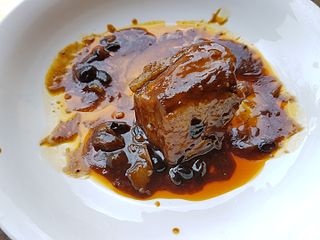
Humbà, also spelled hombà, is a Filipino braised pork dish from Visayas, Philippines. It traditionally uses fatty cuts of pork belly slow-cooked until very tender in soy sauce, vinegar, black peppercorns, garlic, bay leaves, and fermented black beans (tausi) sweetened with muscovado sugar. It also commonly includes hard-boiled eggs and banana blossoms.

Pinatisan is a Filipino cooking process consisting of meat braised in patis, garlic, ginger, onion, black peppercorns, and bay leaves. Some recipes also add non-traditional ingredients like tomatoes, chili peppers, and other herbs and spices. Vinegar may also be added. It is very similar to binagoongan, which is made using fermented shrimp. It is also similar to Philippine adobo and paksiw, but is distinguished by the primary use of fish sauce in place of vinegar. Pinatisan has a strong umami flavor rather than the characteristic sour and sweet flavor of adobo.

Embutido, or embotido, is a Philippine meatloaf made with ground pork and stuffed with hard-boiled eggs and sliced ham or various sausages. It is traditionally wrapped in aluminum foil and steamed, though it can also be baked.

Pininyahang manok, commonly anglicized as pineapple chicken, is a Philippine dish consisting of chicken braised in a milk or coconut milk-based sauce with pineapples, carrots, potatoes, and bell peppers. Some variants of the dish use a chicken stock base instead of milk. The dish originates from Southern Luzon which was once a regional center of pineapple fiber production in the Spanish Philippines.

Paelya or paella (Spanish), is a Philippine rice dish adapted from the Valencian paella. However, it differs significantly in its use of native glutinous rice (malagkít), giving it a soft and sticky texture, unlike the al dente texture favoured in Spanish paella. It is also characteristically topped with sliced eggs. Filipino paelya does not use saffron, but is instead coloured with atsuete (anatto), luyang diláw (turmeric), or kasubhâ (safflower).
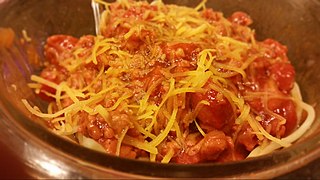
Filipino spaghetti is a Filipino adaptation of Italian spaghetti with Bolognese sauce. It has a distinctively sweet sauce, usually made from tomato sauce sweetened with brown sugar and banana ketchup. It is typically topped with sliced hot dogs or smoked longganisa sausages, giniling, and grated cheese. It is regarded as a comfort food in Philippine cuisine. It is typically served on almost any special occasion, especially on children's birthdays.
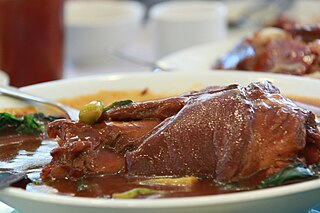
Pata tim, also spelled patatim, is a Filipino braised pork hock dish slow-cooked until very tender in soy sauce, black peppercorns, garlic, bay leaves, and star anise sweetened with muscovado sugar. It also commonly includes péchay and mushrooms. The dish is commonly served in regions in the Philippines with large Chinese Filipino populations, especially in the Binondo district of Manila.
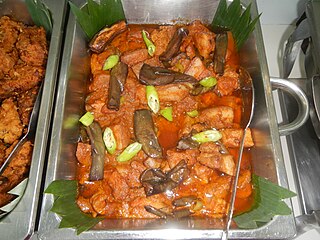
Binagoongan is a Filipino cooking process consisting of vegetables or meat sautéed or braised in bagoong alamang, garlic, black peppercorns, and bay leaves. Some recipes also add pineapples, chilis, or coconut cream to balance the flavors. The dish is characteristically quite salty with a strong umami flavor, which is why it is always paired with white rice and never eaten on its own. It is very similar to pinatisan which is cooked with patis, one of the by-products of fermenting bagoong.

Philippine asado refers to two different Filipino braised meat dishes. The name originates from Spanish asado ("grilled"), a reference to the original dish it was applied to, the Chinese-Filipino version of char siu barbecues usually known as pork asado. However, the Filipino versions have evolved to be braised, not grilled. The other Filipino dishes also known as asado are asado de carajay and asado matua. Unlike the Chinese-derived version, they are savory rather than sweet.

Ginataang manok is a Filipino chicken stew made from chicken in coconut milk with green papaya and other vegetables, garlic, ginger, onion, patis or bagoong alamang, and salt and pepper. It is a type of ginataan. A common variant of the dish adds curry powder or non-native Indian spices and is known as Filipino chicken curry.
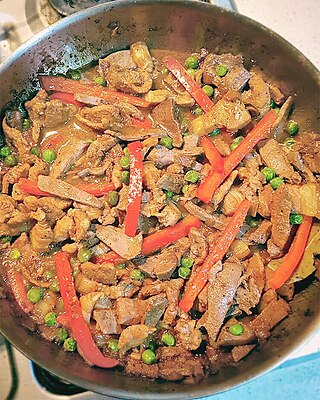
Igado is a Filipino pork dish originating from the Ilocos Region in the Philippines. Its name means "liver" in Spanish for which it features, although it may include other pork meats and offal also.
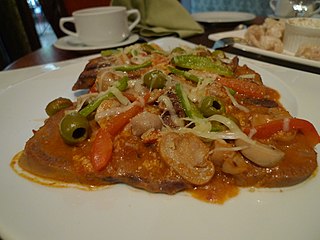
Lengua estofado, sometimes known as lengua estofada or simply lengua, is a Filipino dish consisting of braised beef tongue in a sweet sauce with saba bananas, potatoes, or mushrooms. It originates from the similar Spanish and Latin American dish estofado de lengua but differs significantly in the ingredients. The dish is prominent in the regional cuisines of the Kapampangan, Ilonggo, and Negrense people. It is usually prepared for Christmas dinner and other special occasions.
Kinamatisang manok, sometimes also known as sarciadong manok, is a Filipino stew made from chicken braised with tomatoes, siling mahaba, garlic, onion, bay leaves, fish sauce, black peppercorns, and usually carrots, potatoes, pechay, green peas, and/or green beans. It is very similar to chicken afritada and menudo, but differs in the ingredients and the fact that it is cooked with whole tomatoes rather than tomato sauce. The tomatoes used are the small and round indigenous tomato cultivars that are yellow to orange in color, giving the stew a rich orange color; but some modern recipes use commercial tomato sauce and tomato paste instead which results in a more reddish color. It is eaten served with white rice.

